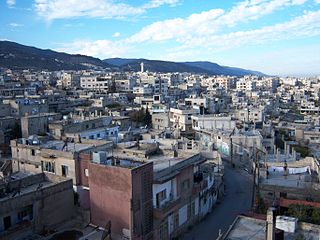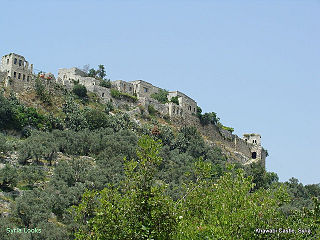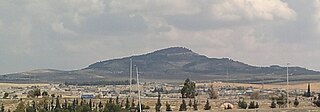
Masyaf is a city in northwestern Syria. It is the center of the Masyaf District in the Hama Governorate. As of 2004, Masyaf had a religiously diverse population of approximately 22,000 Ismailis, Alawites and Christians. The city is well known for its large medieval castle, particularly its role as the headquarters of the Nizari Ismailis and their elite Assassins unit.

Several different denominations and sects of Islam are practised within Syria, who collectively constitute approximately 87% of the population and form a majority in most of the districts of the country.
Abū Aḥmad ʿAbd Allāh ibn Muḥammad ibn Ismāʿīl, was a descendant of the Islamic prophet Muhammad and the eight of the Isma'ili Imams, succeeding his father, Muhammad ibn Isma'il. Abd Allah traveled throughout Persia and the Middle East. At an unknown date, in the first half of the 3rd/9th century, he found refuge in Syria, where he eventually re-established contact with some of his da'is, and settled in Salamiyah, continuing to pose as a Hashimite merchant. Abd Allah did not reveal his true identity publicly and only a few high ranking Isma'ili hujjats and da'is were aware of his whereabouts. He is known by the epithets al-Wāfī and al-Raḍī. Abd Allah designated his son Ahmad as his successor and died around 828.
Al-Qadmus is a town in northwestern Syria, administratively part of the Tartus Governorate, located northeast of Tartus and 14 kilometres southeast of Baniyas. Nearby localities include Kaff al-Jaa and Masyaf to the east, Wadi al-'Uyun and al-Shaykh Badr to the south, Hammam Wasel, al-Qamsiyah and Maten al-Sahel to the southwest, Taanita to the west, al-Annazeh to the northwest and Deir Mama to the northeast. It is situated just east of the Mediterranean coast and its ruined castle stands on a plateau roughly 850 metres above sea level and just above the town.

Muslims, including Shia, Sunni, Ibadi and other branches, agree on the three holiest sites in Islam being the Masjid al-Haram in Mecca; the Masjid an-Nabawi in Medina; and the Masjid Al-Aqsa in Jerusalem.
The Kaysanites were a Shi'i sect of Islam that formed from the followers of Al-Mukhtar. They traced Imamate from Muhammad ibn al-Hanafiyyah and his descendants. The name Kaysaniyya was most likely derived from the name of Mukhtar's chief guard, Abu Amra Kaysan.
Farhad Daftary is a Belgian-born Iranian-British Islamic scholar who is co-director and head of the Department of Academic Research and Publications at the Institute of Ismaili Studies in London. He is related to the Aga Khan IV.

Saleh al-Ali or Shaykh Saleh Ahmad al-Ali was a Syrian leader who commanded the Syrian Revolt of 1919, one of the first rebellions against the French mandate of Syria before the Great Syrian Revolt.

The Alawite revolt was a rebellion, led by Shaykh Saleh al-Ali against the French authorities of the Occupied Enemy Territory Administration and later as part of the Franco-Syrian War against the newly established French Mandate of Syria, primarily in the coastal Jabal Ansariyah mountain range. The revolt was one of the first acts of armed resistance against the French forces in Syria, and its leader, Shaykh Saleh, declared his allegiance to the provisional Arab government in Damascus. He coordinated with the leaders of other anti-French revolts in the country, including the revolt of Ibrahim Hananu in the Aleppo countryside and Subhi Barakat's revolt in Antioch.
Aqarib (Arabic: عقارب, also known as Aqarib al-Safiyah is a town in northern Syria, administratively part of the Hama Governorate, located 45 kilometres east of Hama at the edge of the Syrian Desert. Nearby localities include Salamiyah and Tell al-Tut to the southwest, Uqayribat to the southeast and Sabburah to the north. According to the Syria Central Bureau of Statistics, Aqarib had a population of 3,830 in the 2004 census. Its inhabitants are predominantly Ismailis.

Khawabi, also spelled Qal'at al-Khawabi is a village and medieval citadel in northwestern Syria, administratively part of the Tartus Governorate, located 20 kilometers northeast of Tartus and 12 kilometers east of al-Sawda. According to the Syria Central Bureau of Statistics, Khawabi had a population of 1,039 in the 2004 census. Its inhabitants are predominantly Sunni Muslims. The village formerly had a significant Ismaili population until the early 20th century, and during the medieval period, its citadel served as a center of the Ismaili community when they were known as the Assassins. The citadel itself has been inhabited since at least the 12th century.
Sabburah is a town in northern Syria, administratively part of the Hama Governorate, located east of Hama and 25 kilometers northeast of Salamiyah, on the western edge of the Syrian Desert. Nearby localities include Aqarib to the south, Mabujah to the southeast and Khunayfis and al-Saan to the northeast.

The Nizari state was a Nizari Isma'ili Shia state founded by Hassan-i Sabbah after he took control of the Alamut Castle in 1090 AD, which marked the beginning of an era of Ismailism known as the "Alamut period". Their people were also known as the Assassins or Hashashins.
Al-Kafat is a Syrian village located in the Salamiyah Subdistrict of the Salamiyah District of the Hama Governorate. According to the Syria Central Bureau of Statistics (CBS), al-Kafat had a population of 1,893 in the 2004 census. Its inhabitants are predominantly Ismailis.
Tall ad Dirrah is a Syrian village in the Salamiyah Subdistrict in Salamiyah District, located southeast of Hama. According to the Syria Central Bureau of Statistics (CBS), Taldara had a population of 5,986 in the 2004 census. Its inhabitants are predominantly Ismailis.
Al-Sa'an is a Syrian town located in the al-Sa'an Subdistrict in Salamiyah District, located in the Syrian Desert, 50 kilometers northeast of Salamiyah and northeast of Hama. According to the Syria Central Bureau of Statistics (CBS), al-Sa'an had a population of 3,360 in the 2004 census. Its inhabitants are predominantly Ismailis.
Ba'amrah is a Syrian village located in the Ayn Halaqim Subdistrict of the Masyaf District in Hama Governorate. According to the Syria Central Bureau of Statistics (CBS), Ba'amrah had a population of 508 in the 2004 census. Its inhabitants are predominantly Alawites.
Aqir Zayti is a village in northwestern Syria, administratively part of the Tartus Governorate, located in the Syrian Coastal Mountain Range, east of Tartus. The village of Khirbet al-Faras is located immediately south. According to the Syria Central Bureau of Statistics (CBS), Aqir Zayti had a population of 783 in the 2004 census. Its inhabitants are predominantly Ismailis, who moved there after being forced out from the nearby fortress village of Khawabi in the early 20th century.

Jabal Kafraa is a mountain near Kafraa in the Hama Governorate in Syria. It has an elevation of 625 meters and is located near Jabal Zayn al-Abidin, it ranks as the 30th highest mountain in Hama and the 540th highest in Syria.








